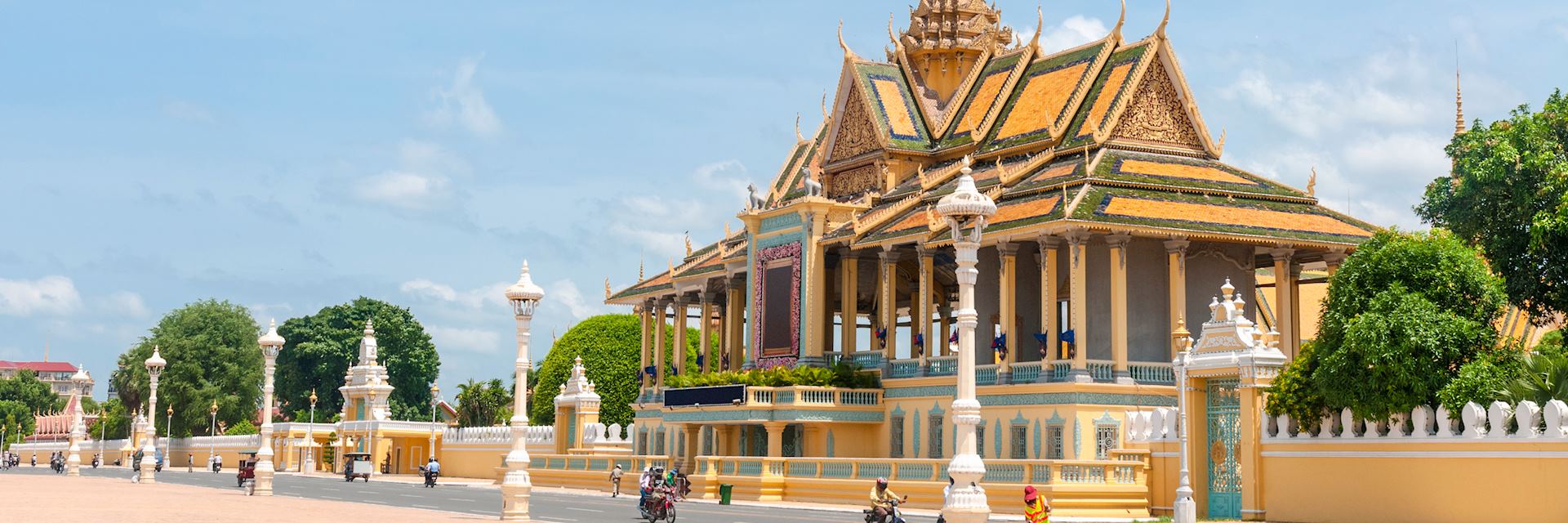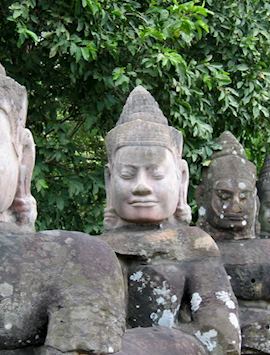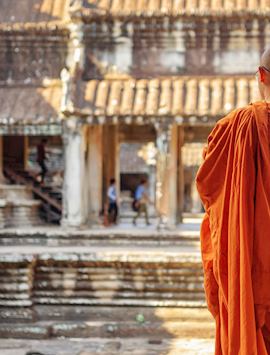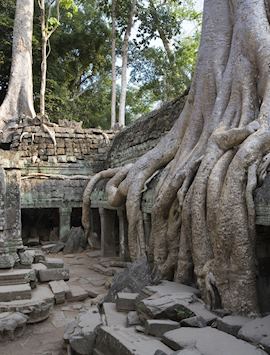By Cambodia specialist Mark
Cambodia and Vietnam, or Cambodia and Laos? While I’m a big advocate of cross-border trips in Indochina, if you’re really looking to explore Cambodia the improving infrastructure is gradually opening up the country, and it now warrants two or three weeks of your time.
You can easily expand the traditional route between Phnom Penh and Siem Reap to include visits to remote temples that predate Angkor, newly accessible national parks and long stretches of silvery sand, all of which you can combine into one cross-country trip.
Phnom Penh

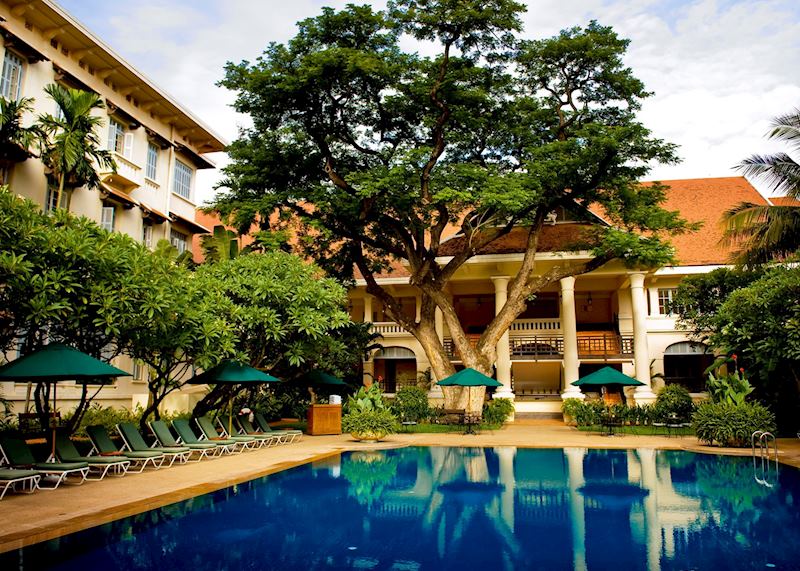
Due to its flight connections, Phnom Penh is logistically a good place to start your trip. But, it’s also a starting point to understanding Cambodia’s history, from pre-Angkorian art at the National Museum of Cambodia to the Killing Fields and S21 museum. You could stay in Raffles Hotel Le Royal, whose past life as a Red Cross hospital graces the walls in old photographs.
As well as marking the past, the city is forging ahead. Hotels now inhabit skyscrapers, like the Rosewood Phnom Penh, whose contemporary suites take up a few floors of the gleaming Vattanac Capital Tower. At dusk, head to the hotel’s sky bar, Sora, to see the neon-lit capital spread below.
Phnom Penh also has a flourishing craft brewery scene, and you can sample a selection of domestic pilsners, wheat beers and India pale ales on an evening tour with a local resident. If cocktails are your tipple, spend the night hopping between swanky lounges and hole-in-the-wall bars.
An overland adventure to Siem Reap
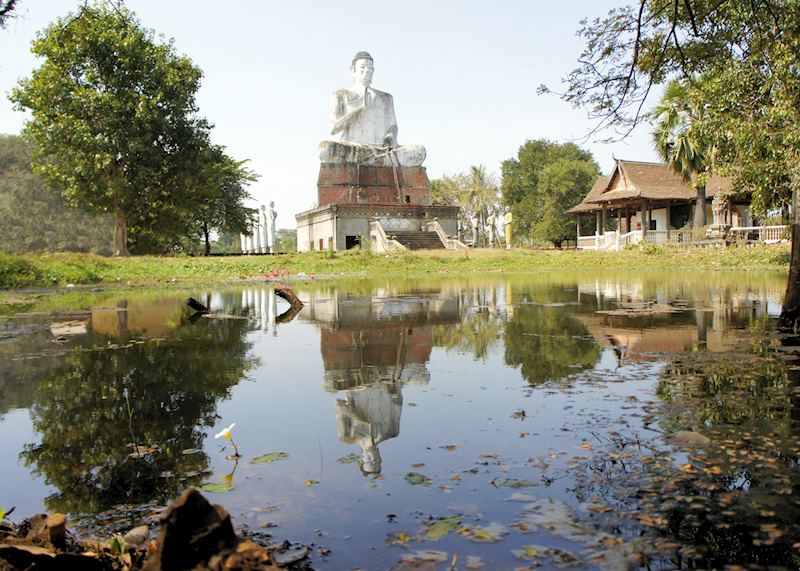
Traditionally, I’ve suggested journeying from Phnom Penh with an overnight stay in the colonial city of Battambang. But, if you’re looking for something more adventurous, you could now travel to Siem Reap via little-visited temples, with a driver and guide.
Your first stop, about four hours’ drive north of Phnom Penh is Sambor Prei Kuk temple complex, a UNESCO World Heritage Site since 2017. This is the location of Ishanapura, the capital of the 6th-century Chenla Empire, which preceded the Khmer. As you explore the temples, you’ll see how the architecture here laid the groundwork for the Angkor period.
Continuing for a couple of hours, you come to Preah Khan Kompong Svay, a Khmer complex almost twice the size of Angkor. Its remote location draws few visitors, but (one better) — you can spend the night here at a private camp just outside the complex. As the sun begins to set, you sit down to eat some Khmer specialties by candlelight, distracted by the occasional flicker of a bat above.
Then, as evening sets in, you head into the temples with a guide, to explore by the light of a flaming torch. In the internal chambers, I held up my torch to examine the figures etched into the wall. They were, my guide explained, precursors to the carvings at Angkor.
Cambodia’s out-of-the-way temples
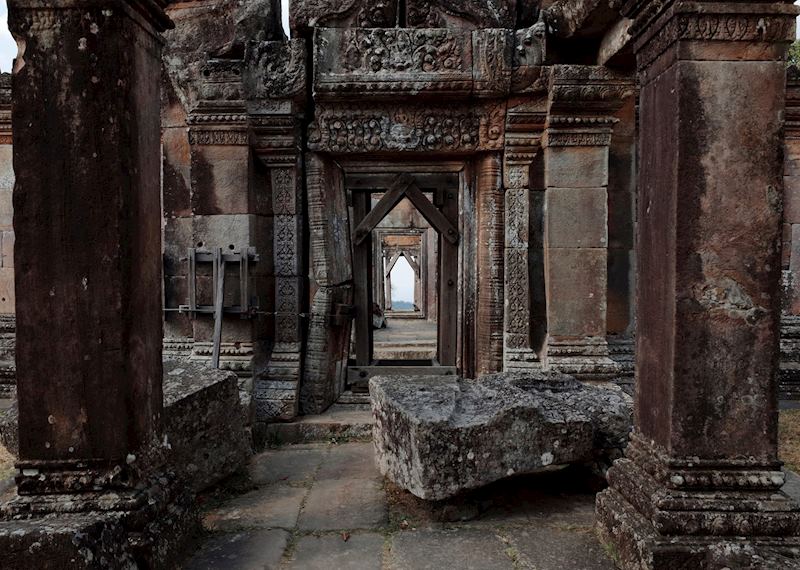
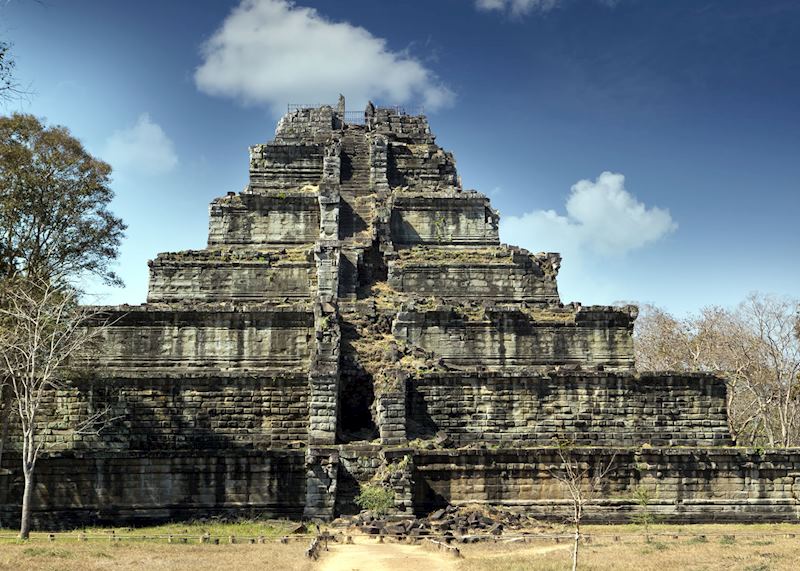
It’s a day’s drive from the temple campout to Siem Reap, but you can visit more temples along the way. I’d embrace them all — there’s a good reason for visiting each of these largely undiscovered sanctuaries.
Preah Vihear is another fine example of Khmer architecture, but you’re really here for the location. Built on a hill overlooking the flat rural plains of Cambodia and Thailand, few Khmer temples claim such a view. Long closed to visitors due to an ownership dispute with Thailand, it’s now once again open and cared for by a family who live on site.
After Preah Vihear, you could also stop at Koh Ker. From a distance, its multi-tiered temple, Prasat Thom, looks like a hill. But, up close, you’ll see that each sandstone tier is topped with frothy jungle greenery that softens the silhouette.
Looking more akin to a Maya temple, Prasat Thom rose during a brief period when the Khmer capital was moved here from Angkor by King Jayavarman IV. You can wander a ruined city of palaces, libraries and smaller temples that were built to please the new King.
Temples of Angkor and Siem Reap’s food scene
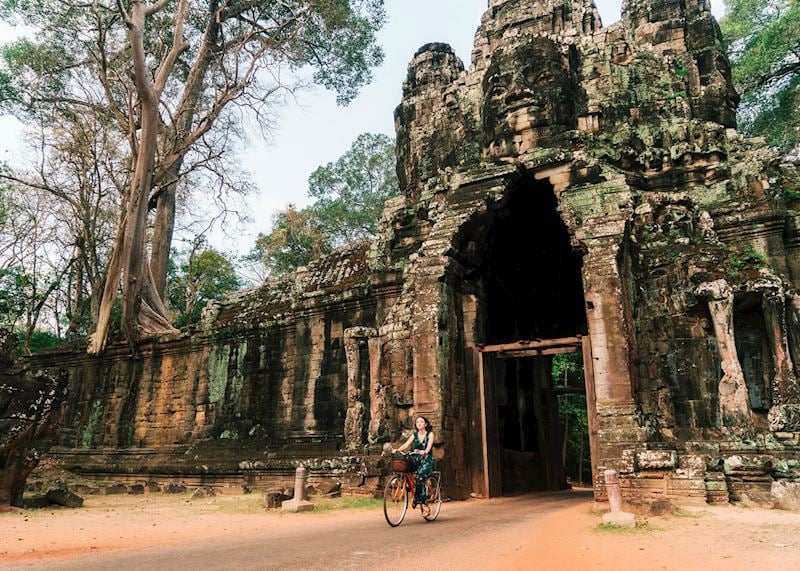
Someone’s always coming up with a novel, new way to explore the Temples of Angkor. But, of all the options, I’d have to recommend a guided cycling tour. It leads you off-road through the jungle to temples that aren’t on any fold-out tourist map.
Bypassing Angkor Thom’s busy south gate, you cycle up onto the ancient city wall. This 5-m (16-ft) wide pathway is trimmed with scrub to stop you getting too close to the edge. Entering the complex by the overgrown Gate of the Dead, it felt like we’d sneaked into an undiscovered temple when, in fact, we were in the heart of Angkor.
Angkor’s visitor-attracting temples have led to Siem Reap becoming the focal point for Cambodia’s hospitality industry. A list of internationally renowned Khmer chefs have made their name here.
On a dine-around tour across the city, you can get a taster for this burgeoning food scene. Hopping between four or five of Siem Reap’s best restaurants by tuk-tuk with your guide, you’ll try a range of dishes from traditional Khmer specialties to French-influenced tasting platters.
Southern Cambodia’s national parks

For a long time, southeast Cambodia wasn’t thought of as a travel destination. There was a lack of places to stay — in fact, a lack of much at all. But, two tented camps have changed that.
I won’t mislead you into thinking it’s anything other than remote, though. By the time you’ve flown from Siem Reap to Sihanoukville Airport (the nearest), driven for two and a half hours then boated 40 minutes up the river, you’re in the middle of nowhere.
And, while it’s not on the scale of the Big Five, there is wildlife here. The staff will help you find it (or gently remove it from your tent) within the surrounding forests of Botum Sakor National Park. The ecolodge has just nine safari-style canvas tents, raised on stilts above the grasslands. Inside are proper beds, locally made furniture and a hot-water bathroom.
You can take guided kayak or hiking tours in the surrounding forest and waterways, but the highlight is joining the forest rangers. You can visit Preal Tachan Station, a remote ranger outpost, to join a jungle patrol. As well as looking out for snares and checking camera traps, the ranger I accompanied could spot a tokay gecko or white-breasted kingfisher from the merest quiver of a tail.
The camp provides income to protect the park, working alongside the Wildlife Alliance.
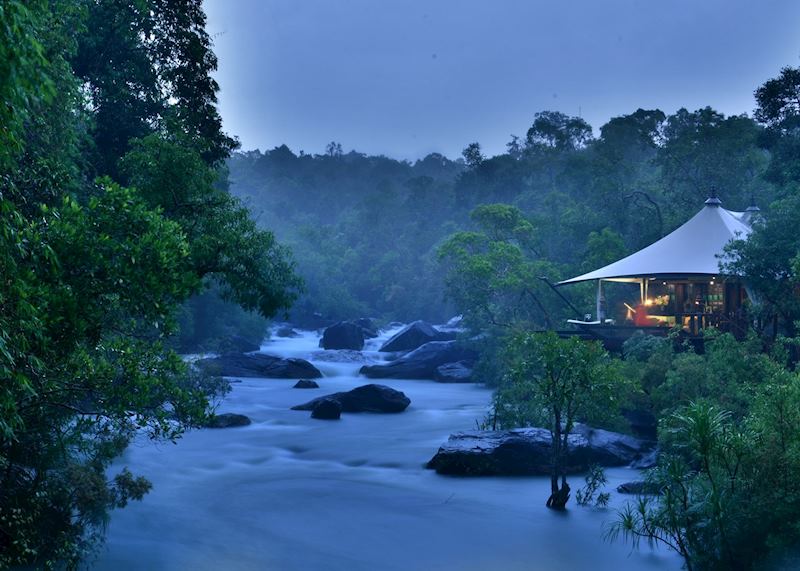
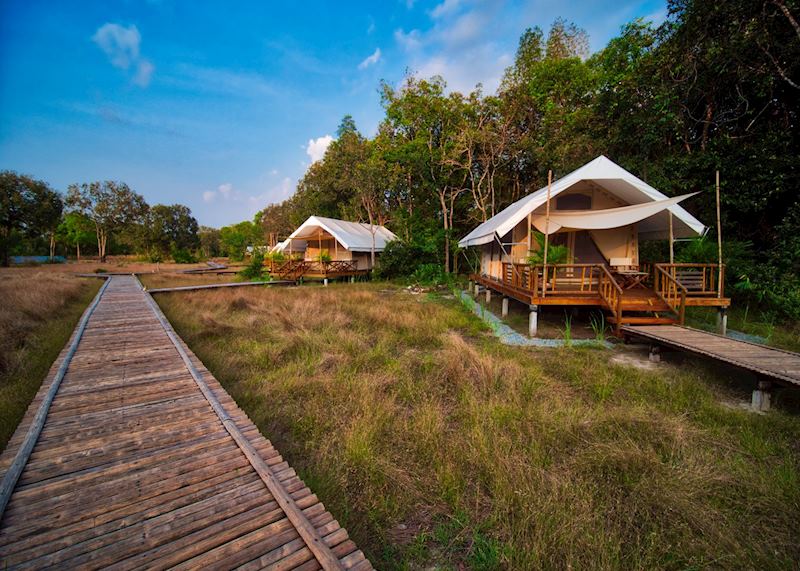
If you’d rather enjoy nature from a freestanding, gilded bathtub (prepared by your private butler) Shinta Mani Wild is the no-expense-spared alternative. This 15-tent camp has been designed by Bill Bensley — who likens hotel design to preparing the set of a Hollywood movie — along a 1.5 km (1 mile) stretch of river. It’s a three-hour drive from Sihanoukville airport or a four-hour drive from Phnom Penh.
With unlimited spa treatments, private butlers and the most extravagant tents I’ve seen, it’s definitely an indulgent stay. But, the primary aim of the camp is to provide employment for local people, fund education initiatives and, like Cardamom Tented Camp, support the Wildlife Alliance. And, with Kirirom, Cardamom and Bokor national parks on its doorstep, you have plenty to explore.
The focus here is more on Cambodia’s flora. You can join Wildlife Alliance rangers on guided jungle hikes and, if you like, zip-line back into camp.
Kampot and Kep: up-and-coming small-town Cambodia
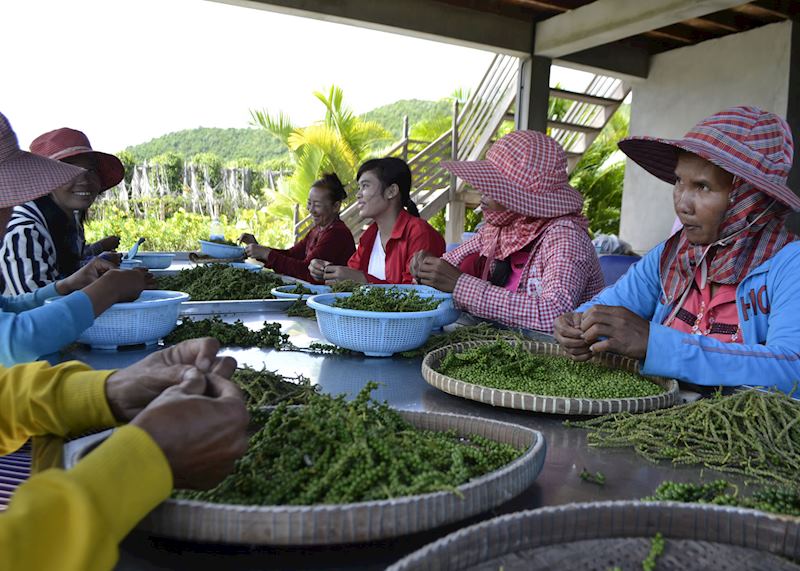
Coastal Kampot is an agricultural town where much of Cambodia’s pepper is produced, markets sell dried fish and coconuts, and the architecture is yellowed French-colonial. You can spend balmy evenings pottering about the markets and eating alfresco at one of the refurbished Chinese-shophouse restaurants. For much of the same, but with sand thrown in, consider the nearby town of Kep.
Regardless of where you lay your head, take the time to tour La Plantation, an organic pepper farm at the forefront of Kampot pepper’s post-civil-war renaissance.
As well as walking through the groves and sampling the estate’s eleven types of pepper, you can take an alfresco cooking class. Looking out across the surrounding hills, you’ll learn how to make beef lok lak and fish amok from scratch (down to pulping a coconut) while discovering the importance of pepper as a Khmer seasoning.
You could stay in Rikitikitavi, a guesthouse on the riverfront in Kampot or at the oceanfront boutique Knai Bang Chatt in Kep.
Cambodian beach stay finale
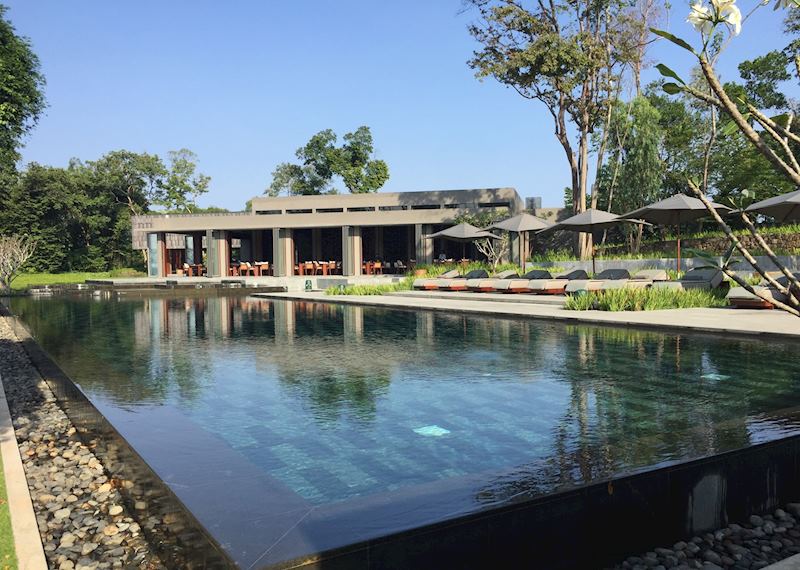
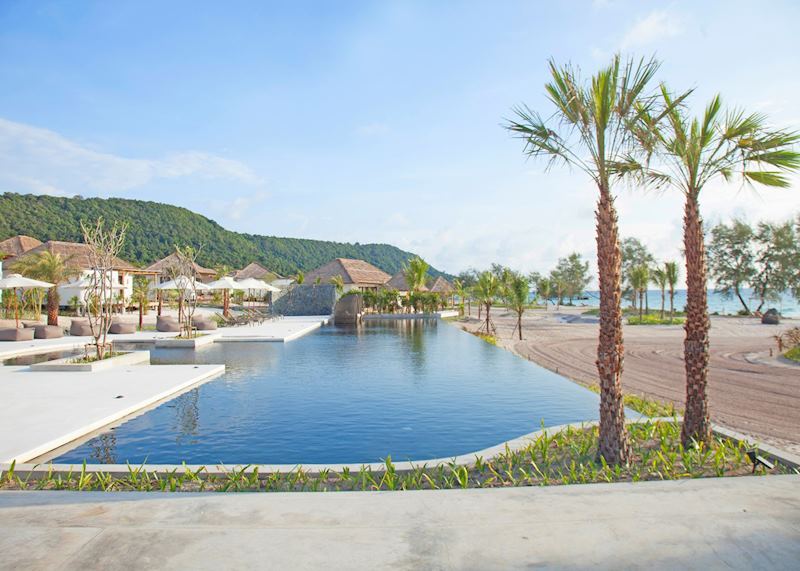
In my experience, few beaches compare to Cambodia’s (the sand is so soft it squeaks). Beach hotels are popping up along the coast, but the best experiences are a speedboat-ride away on the surrounding islands. Sihanoukville acts as the gateway, with an airport and good road connections.
If the beach itself is your priority, there’s the aptly-named 7-km (4.3-mile) Long Beach on Koh Rong Island. A small fishing village signals one end, and The Royal Sands resort the other, but the rest of the beach is an undisturbed stretch of the whitest sand I’ve ever seen, trimmed with teak and tamarind trees. Each Royal Sands villa overlooks a fluorescent blue ocean, which is warm enough to make the resort’s infinity pool unnecessary.
Part of Koh Rong National Marine Park, the island is surrounded by coral gardens thick with fronds. There’s a long list of snorkel and dive spots a boat ride away from Long Beach, many sheltering the park’s most important residents — nine rare species of seahorses.
To finish your stay with hands-down luxury, Alila Villas on the tiny island of Koh Russey pulls out all the stops. Stepping straight out of a design magazine, this ultra-modern resort offers complimentary yoga, an outdoor cinema and a restaurant serving food straight from its organic garden.
Read more about trips to Cambodia
Start thinking about your experience. These itineraries are simply suggestions for how you could enjoy some of the same experiences as our specialists. They’re just for inspiration, because your trip will be created around your particular tastes.
View All Tours in Cambodia
